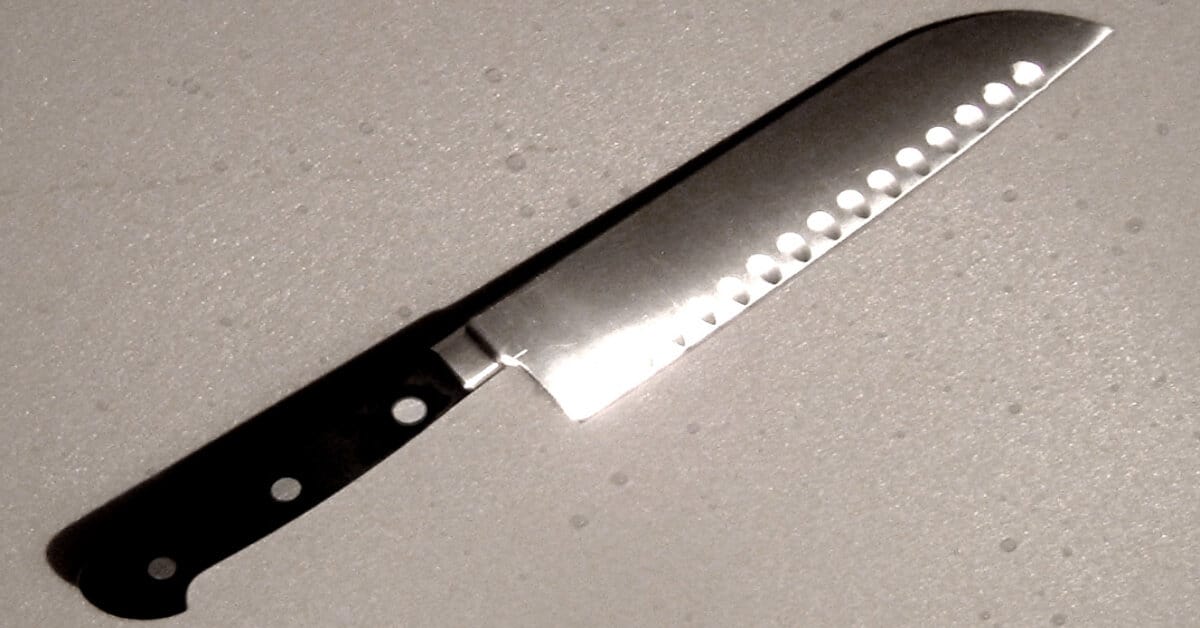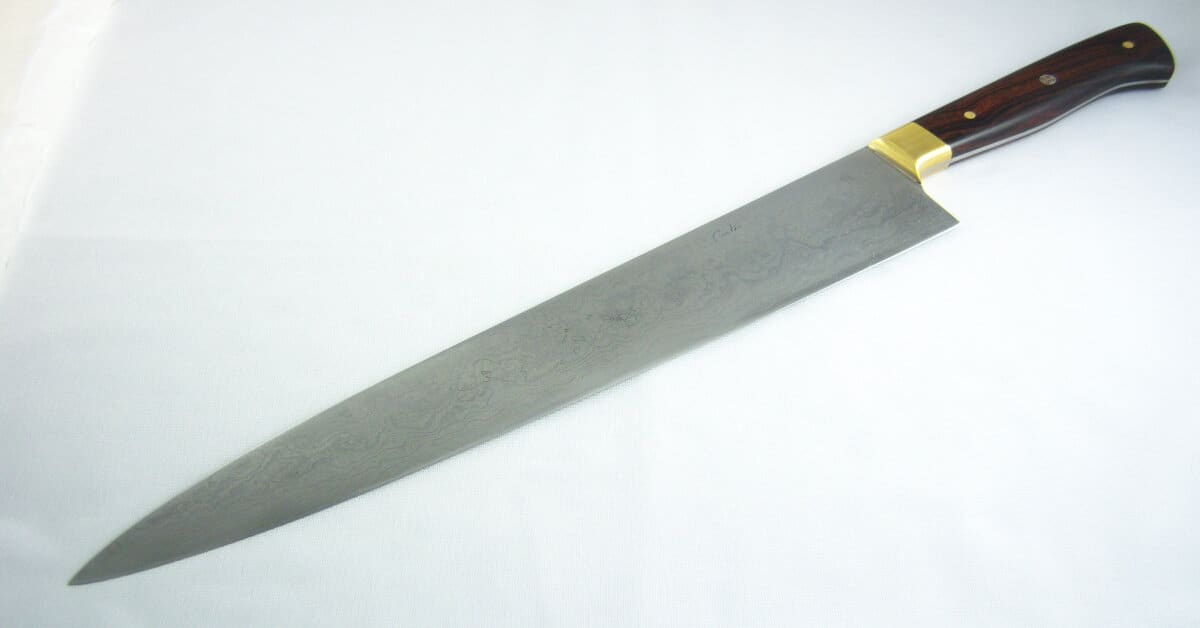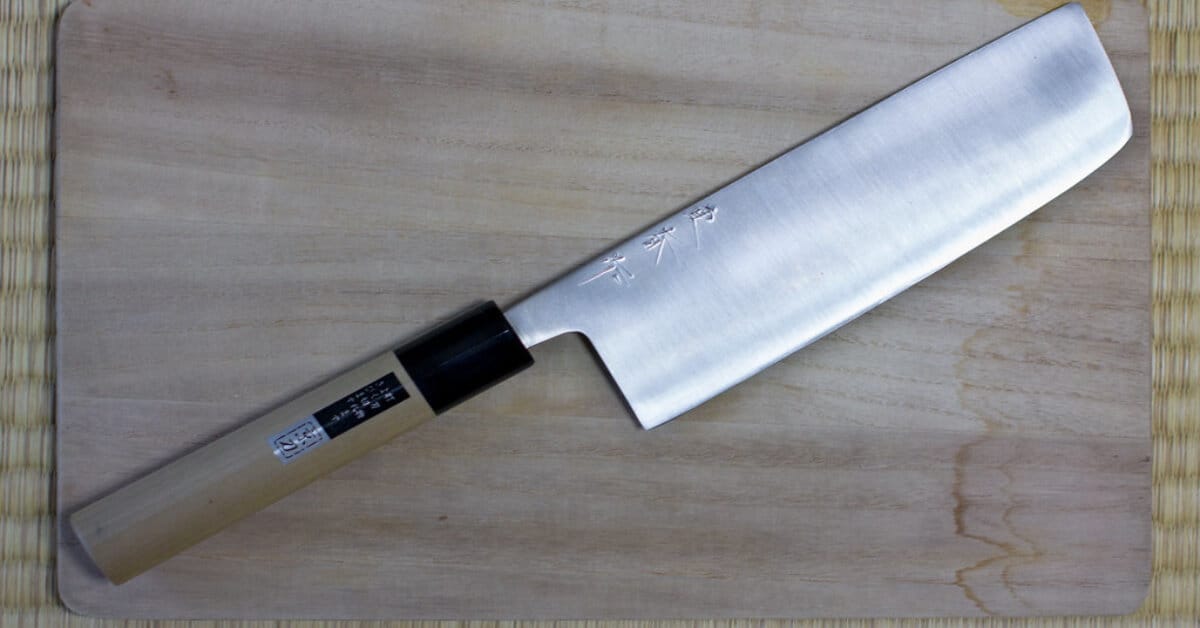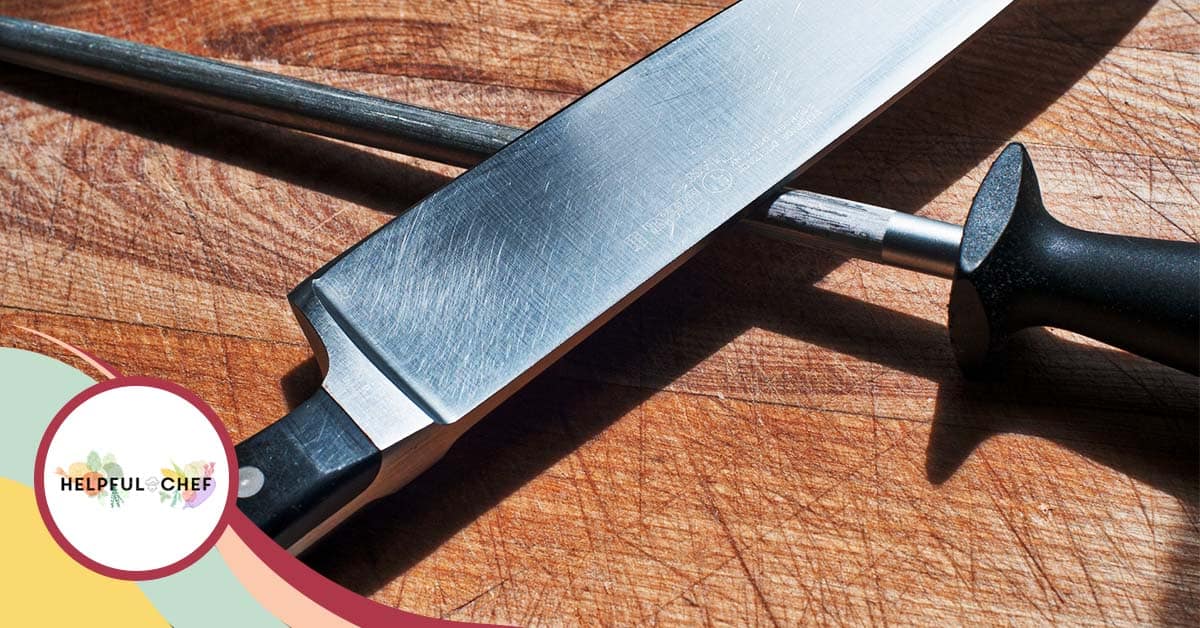The ultimate guide to Kitchen Knives
Kitchen knives are essential tools for any chef. When used properly, they don’t just make your food preparation faster and easier – they actually make it safer too. It’s important to pick the right knife for the job, and know how to use it properly. However, with so many knives out there and so many different things to cook, this can be easier said than done! In this helpful guide to kitchen knives we’ll learn all about kitchen knives, from knife construction to chopping techniques and how to care for your knives.
Let’s start with what kitchen knives are made of as well as the main construction methods used to build them. Then we’ll have a look at the different parts of the knife and why each is important.
What Kitchen Knives Are Made Of
Once you’ve decided what type of knife you want, there are a couple more things to consider before you can buy one. Firstly, you ought to decide what material you want the blade to be made from. The blades can be made of a variety of materials, as outlined below:
Stainless Steel

The most common material used for knives, as it’s both durable and resistant to rust and corrosion.[1] Stainless steel is a tough alloy, made from carbon and iron, with chromium added to repel stains.
Carbon Steel

These blades don’t contain chromium and instead have a higher carbon count, which makes them particularly strong and rigid, while helping them to retain their extremely sharp edge. However, the lack of chromium makes carbon steel blades prone to staining or discoloration, particularly when dealing with acidic foods like tomatoes or lemons.
Damascus Steel

Damascus steel is believed to have been in medieval Damascus and has been used to create knives, swords and other weapons for hundreds of years.[2] By hammering together two or more different alloys, this method of construction creates a beautiful, intricately patterned finish which is extremely strong. Damascus steel knives retains sharp edges for a long time and is particularly durable. The only downside is it can be pretty expensive! Learn more about Damascus Steel.
Ceramic Blades

Crafted with hardened zirconium dioxide, ceramic knives are lightweight, which is a trait some chefs prefer. The ceramic construction is non-metallic, meaning that it won’t rust, it’s more hygienic, and it will not transfer metallic flavors into your food. What’s more, they can also stay sharp for around ten times as long as typical metal blades! However, ceramic blades can be particularly brittle, so they require careful use.
Titanium Blades

Although they are hard, rust-resistant and chemically neutral, the edges on a titanium blade tend to be less sharp, and not asso good at holding an edge. This means that they are not as effective as traditional steel-based or ceramic blades. However, advances in modern knife-making technology means that titanium blades are getting better!
How Kitchen Knives are Made
Forged
Blades can also be produced by two main production methods. forged or stamped.[3] A forged blade is made from a single piece of metal, hammered into shape by a press before being honed and sharpened. Forged steel is extremely strong and durable, and the single piece of metal for blade and tang also keeps the knife well-balanced. Professional chefs worldwide favor forged blades for these reasons. However, forged blades tend to be more expensive than stamped blades, due to their more time-consuming and difficult construction process.
Stamped
Stamped blades are cut from a sheet of metal in the shape of the blade. This cutout is then hardened, sharpened and polished to create the edge. Stamped knives are easier and more cost-effective to produce, so they’re often more affordable than forged blades. They’re also lighter, and this can make them easier for beginners to use too. However, they typically need to be sharpened more regularly than forged knives. If you don’t know how to properly sharpen a knife, don’t worry – we’ll show you how later in this guide.
What Are The Different Parts of a Kitchen Knife?
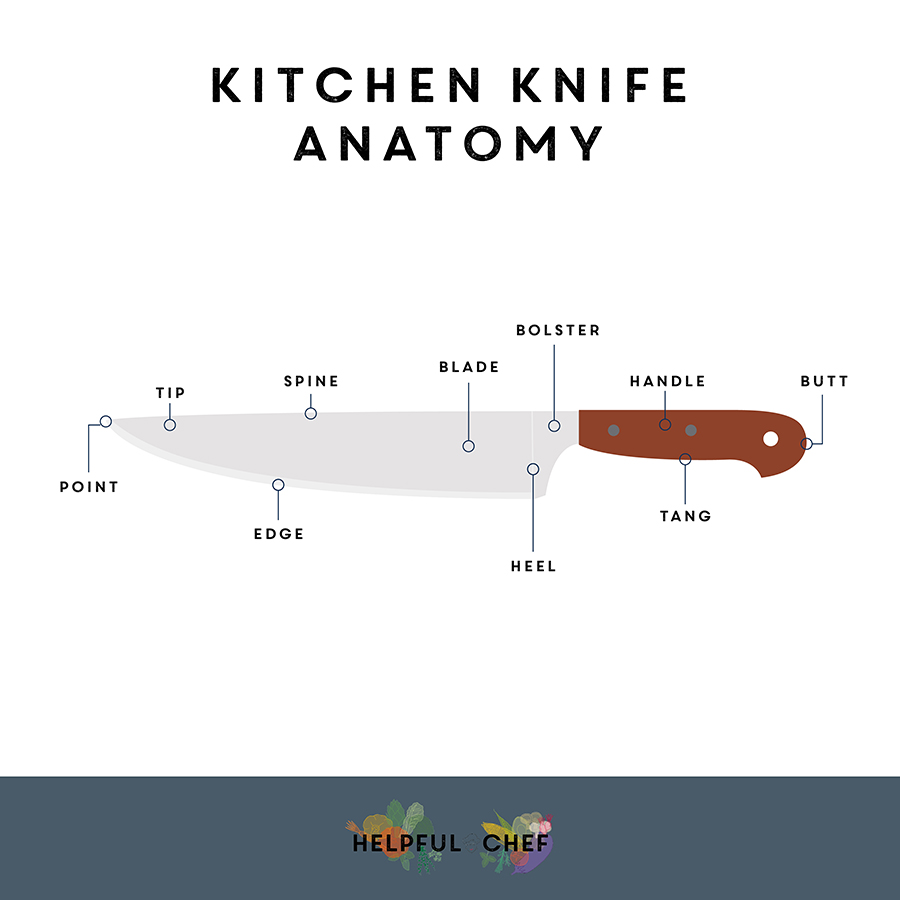
In this section, we will examine the different parts that make up the anatomy of a kitchen knife. It is useful to know the names and locations of these parts in order to differentiate between different knives. This will also help you select the right type of knife for every job.
Point
The very end of the blade, typically sharpened to a fine point. It can be used to pierce or score the surface of food.
Blade
The part of the knife used for cutting. Naturally, this means that the blade is very important!
Edge
The sharpened part of the blade, used for the majority of cutting. A knife’s sharpness is determined by how finely the edge is ground – during construction, and when sharpening yourself.
There are a number of different types of blade edges, each designed to help a knife excel at certain kitchen tasks. A straight or ground edge is the most common type, and is just as the name suggests – a straight, sharp edge. These are typically found on chef’s knives, paring knives, and utility knives. A serrated edge has sharpened grooves and ridges along the blade, perfect for sawing through tough foods, or slicing softer foods without crushing them. Scalloped edges have a row of hollow dimples along the side of the blade, which helps to stop food from sticking to the blade. Lastly, hollow ground edges are typically found on Japanese knives. They taper down from the middle of the blade to create a very fine edge, which results in an extremely sharp but particularly delicate blades that are perfect for making sushi.
Tip
The front part of a knife’s edge, just beneath the point. The tip is used for more delicate or careful chopping and cutting.
Spine
The blunt upper side of the blade, opposite to the edge. Generally, the thicker the spine, the stronger the blade. The spine also helps to provide overall balance to the knife.
Heel
The edge of the blade closest to the bolster. This area of the edge is used when you need more strength or pressure to cut through thicker or tougher foods.
Tang
The unsharpened part of the blade which connects to the handle. The tang is vital to the overall balance, weight, stability, and strength of the knife. A full tang, extending from the end of the blade through to the butt, is often found on the best knives. Sometimes, the tang also functions as the handle.
Handle
The part of the knife a chef holds onto when cutting, sometimes called the ‘scales’. It can be constructed from a range of materials such as wood, laminate, plastics, or the tang of the blade itself.
Bolster
A raised area between the blade and the handle. It provides additional weight to help balance the knife, and also puts a greater distance between the blade and your fingers.
Rivets
Rivets fasten the handle to the tang. Some (typically cheaper) knives use resin or epoxy instead of stronger rivets.
Butt
The end of the handle, at the very bottom of the knife.
The Different Types of Knives (and What They’re For)
In this section, we will learn about what different types of knives are for. We’ve separated them depending on what they’re used to cut, starting with the essentials in the order that we’d recommend when building your knife collection.

Essential Knives
Chef’s Knife

A chef’s knife – also known as a cook’s knife – has a long, broad blade with a straight edge. It is widest across the heel, tapering to a finely pointed tip. The chef’s knife is a great all-rounder. It’s one of the most versatile knives in your kitchen, perfect for everyday slicing and dicing. If you’re thinking about your first knife, we’d recommend that you start with a good quality chef’s knife to start your collection.
Paring Knife

The paring knife has a short, slim, evenly sized blade with a pointed tip. Paring knives tend to be small and light, making them easier to handle and thus perfect for delicate work. They’re great for slicing fruit and veg, as well as a wide range of other kitchen tasks like peeling, trimming and seed removal. And don’t let their small size fool you – paring knives can also make light work of harder foods like potatoes too! After you’ve got a decent chef’s knife, we’d recommend getting yourself a paring knife next.
Utility Knife

The utility knife is similar to the chef’s knife, but slightly smaller and slimmer. Some utility knives also feature a sharp tip, allowing for more detailed cutting. A utility knife shares many of the qualities of a chef’s knife, but at a smaller size. This makes them perfect for smaller foods and vegetables – you’d use a chef’s knife for onions, and a utility knife for shallots. For your third knife, we’d recommend a utility knife.
Bread Knife

Compared to our other essential knives, the bread knife is a bit different – it has a long, serrated edge. This makes it perfect for sawing through all sorts of breads and other softer foods like cakes. This sawing action means that when cutting these sorts of foods, you will retain the overall shape, rather than knocking out all of the air from the food. We would argue that a bread knife is essential too, because of how different it is to our other three essentials. If you have an electric knife, you won’t need a bread knife.
Meat Knives
Boning Knife

A boning knife has a slim blade with a very sharp edge, tapering up to a finely pointed tip. Good boning knives tend to be short and rigid. This makes them light and maneuverable, but hard enough to cut through meat bones and cartilage to create the perfect joint of meat. For deboning pork and beef, we’d recommend a harder blade, and for poultry we’d go for a more flexible blade.
Carving Knife

Carving knives are long and slim, with a sharp point. Their narrow width and longer length enables you to cut clean, uniform slices with a single cutting motion. This makes carving knives the perfect tool for serving poultry, pork, lamb, or beef.
Cleaver

The recognizable blade of the cleaver, or butcher’s knife, is flat and rectangular. Cleavers are some of the broadest, heaviest knives, used for chopping up raw meat into more manageable sizes. Their weight enables them to cut through bone, making the cleaver one of the best knives for cutting meat, butchery or other raw meat preparation, such as dividing meat into smaller portions before cooking.
Fish Knives
Fillet Knife

A filleting knife looks similar to a boning knife, but with a thinner and more flexible blade. It has a long, slim blade with a very sharp edge and a pointed tip for piercing skin and removing fishbones without damaging the delicate flesh. By cutting horizontally, you can cut around the fish’s backbone for perfect fillets. If you like to cook with fish a lot, you should definitely invest in a quality fillet knife. You can also get electric fillet knives too.
Salmon Knife

The first thing you’ll notice about a salmon knife is how long the blade is. The slim and sharp blade enables precise filleting and skin removal, and this precision means less waste. It’s also flexible and double-edged, which makes it perfect for filleting larger fish. Often, salmon knives feature indentations along the surface of the blade, which helps to reduce drag whilst cutting and stops the raw fish sticking to the blade. Interestingly enough, Salmon knives are also excellent knives for slicing brisket too, due to the soft and fragile nature of the meat.
Santoku Knife

Originally called ‘santoku bocho’, meaning ‘three virtues’ or ‘uses’, santoku knives are perfect for precise cutting, dicing, and mincing. The dropped point and long, slightly tapered blade allows for precise and intricate cuts. Often, santoku blades will feature dimpling or indentation to help prevent food sticking to the blade. The sharp, straight edge favors an ‘up-and-down’ cutting technique, rather than the rocking motion more commonly used in Western kitchens. As well as being suitable for many cutting techniques, the santoku knife is also suitable for many foods too – not just fish, but meat and particularly vegetables too. This makes the santoku knife a great alternative to a chef’s or utility knife.
Vegetable Knives
Tomato Knife

The tomato knife has a serrated blade between six and seven inches long, perfect for cutting and slicing through delicate tomatoes without squashing their soft centers. They often have a sharp or forked point too, for transferring tomato slices to plates or pans after cutting.
Peeling Knife

A peeling knife has a short, rigid and curved blade. It’s straight and particularly sharp edge can be used to peel fruit, veg and potatoes, and it can also slice through skins too.
Nakiri Knife

Also known as a Japanese vegetable knife, the nakiri knife is less commonly found in Western kitchens. Nakiri blades tend to have a hollow ground edge, which is very sharp. Their broad, rectangular shape and straight edge make them excellent knives for cutting vegetables – there no need to rock the blade backwards and forwards. This makes a nakiri knife the perfect tool to tackle larger, more difficult veg like squashes, swedes, or sweet potatoes. It’s also perfect for shredding cabbage or lettuce, or creating particularly thin, even slices of veg for decoration. Check out the best Nakiri Knives here.
Other Knives
Steak Knife

Steak knives are table knives rather than knives for food preparation. They have a serrated edge and sharp point to allow you to smoothly saw through tougher meats at the table. You could use steak knives for burgers, and of course, steaks.
Crinkle-cut Knife
The crinkle-cut knife is a specialized knife used to give fruits or vegetables a novel wobbly edge. And as you might have guessed, this knife is the one to reach for if you’re craving crinkle-cut fries!
Mincing Knife
The mincing knife, or ‘mezzaluna’, is a distinctive curved blade with two handles, ideal for finely mincing ingredients like herbs, onions or garlic.
Knife Sets Versus Individual Knives
It’s also worth deciding whether you want to buy your knives individually, or if you’d prefer to go for a knife set. Buying a knife set can be great to kick off your collection quickly, and most knife sets will include all four of the essential knives, and perhaps some others too. Top-quality knife sets often include a knife block for storage, and sometimes other extra items such as a honing steel or pair of kitchen shears. It’s a nice bonus that they’ll all have the same design too!
However, you should be sure to consider whether you need a knife set. Sometimes, you’ll end up with knives that you’ll never use! Also, you may find that buying one or two high quality knives works out more economical and effective than buying a full knife set of lower-quality blades. In China, many chefs rely on a single, high-quality knife rather than a wide range of knives, so it could be worth your while investing in a smaller number of more expensive and better knives rather than a larger collection of cheaper knives.[4]
How to Use a Kitchen Knife Effectively
Now that you know all about the different types of kitchen knife, how they are made, and what they are made of, let’s look at how to use them properly and safely.
How to Hold a Knife
It’s really important to learn how to hold your knife correctly, for obvious reasons. Of course, you’re able to chop food holding a knife in all sorts of ways, but this quick method is great for uncertain beginners, as well as expert chefs interested in checking their knife skills. It gives you more control over the blade whilst keeping all your fingers attached!

To begin, grip the handle with your dominant hand, then pinch with your finger and thumb to ‘choke’ the blade. This gives a controlled grip that doesn’t strain your wrist. You can also choke the blade between the thumb and two fingers if you find this more comfortable. Paring knives and other shorter knives aren’t long enough to choke properly, so for these knives, you should just grip the handle instead. Be sure to avoid chopping with an extended index finger across the spine of the blade though, as it’s less stable and puts unnecessary stress on the tendons in your hand, which means you’ll get tired chopping much sooner.
If you’d like to see a demonstration, Jon-Paul Hutchins, an instructor at the prestigious French cooking school Le Cordon Bleu, will show you how in the video below.
Guide to Kitchen Knives: Chopping Methods
Now you know how to hold your knife properly, let’s have a look at some important chopping methods. There are many techniques, which you can choose based on personal preference and what you’re trying to cut.[5]
Cross Chop
The cross chop is the perfect method for beginners looking for finely chopped herbs, onions, garlic, or other vegetables. Hold the knife in your hand, placing the tip of the knife on your chopping board at about 20 degrees. Next, place the palm of your other hand on the spine of the blade, keeping your fingers straight out to steady the blade. Then, just raise and lower the handle of the knife, using your other hand to keep the tip of the blade from leaving the board. Use a sweeping motion with the blade to gather up ingredients that may get scattered about. Soon, you’ll have finely chopped whatever is beneath your blade!
Tap Chop
The tap chop should only be used on veg with flat, stable sides – you can cut one flat side yourself if you need to. Place the vegetable flat side-down on your chopping board, then hold the veg with your weaker hand in a claw shape, tucking your fingers in. Then carefully chop up and down with the knife in your stronger hand. Use your thumb to move the veg forward as you chop, and the joints of your tucked-in fingers to guide and control the blade, keeping your fingertips out of the way. Don’t try to go too fast until you can cut safely and consistently every time!

Rock Chop
The rock chop is great for a range of veg, and works best on thicker skinned veg like peppers, chilies and some tomatoes. Hold the veg with your weaker hand in a claw shape, just like with the tap chop, and keep your fingers out of the way. Then, chop in a circular motion, rocking the blade from tip to heel. Use your other hand to move the veg and guide the blade. Again, consistency is the key here – not speed.
Below is a video demonstration demonstrating these cutting techniques – watch the hand positions closely!
How to Look After Your Knives
With a bit of love and affection a good knife can easily last you a lifetime. Read on to learn how to properly care for your knives.
How to Clean a Knife
Proper cleaning can extend your knife’s lifespan significantly. Although many modern knives are dishwasher-safe, we always recommend hand washing your knives under warm, running water. Use a little bit of washing up liquid and gently wipe the blade, then carefully dry off and put away to prevent any damage from moisture or humidity.
How to Sharpen a Knife
It’s also really useful to know how to sharpen your knives, especially if you’ve invested in some expensive ones! A blunt knife can actually be more dangerous than a sharp knife, as the greater pressure needed to cut through food makes the blade much more likely to slip.
There are a range of tools you can use to sharpen or hone your knife’s edge. The video below demonstrates how to use a honing steel, pull-through sharpener, and a whetstone.
How to Keep your Knife Sharp
There are a number of things you can do to keep your knives sharp. Firstly, storage. How you store your knives can have a huge impact on their sharpness. There are a number of options: cases, knife blocks, magnetic racks, sheaths, or even a dedicated knife drawer.
Cases are typically used by professional chefs, who tend to have a large collection of high-quality knives that often need transporting.[6] For home chefs, we’d recommend a knife block or magnetic rack. Storing your knives this way protects the blades from wear, and protects you from the blades too! You’re more likely to cut yourself on a rogue blade if your knives are stored in a drawer, so if you choose this storage option, we’d definitely recommend getting sheaths for your blades if they weren’t included when you bought them.
The surface you chop on can also impact the sharpness of your knives. For your cutting surface, we’d avoid glass or metal if possible, as they can dull the edge of your knife, or even damage or chip particularly hard, fragile knives. Ideally, you should stick to bamboo or wood chopping boards. Plastic is okay, but it’s more prone to harboring bacteria in the cuts than bamboo or wood. If your chopping board doesn’t have rubber feet, one quick tip is to place a damp cloth or kitchen towel underneath it to help stop it slipping around. Lastly, when gathering ingredients on your chopping board, it’s usually best to try and use the blunt spine of your blade rather than the edge, as scraping the edge across the chopping board can dull it.
Conclusion
As Japanese chef Masaharu Morimoto says, ‘A kitchen without a knife is not a kitchen’.[7] Indeed, knives are an essential tool for anyone who cooks – from complete beginners to professional chefs. By using your knives correctly, you should find that your food preparation is easier, faster, and safer, ultimately leading to a more enjoyable time spent in the kitchen. After reading this helpful guide, we hope you’re feeling more confident with the different types of kitchen knives and their uses.
FAQs
Q: Why aren’t my knives cutting properly?
A: First things first, make sure you are using the right knife for whatever you’re trying to cut. When starting out, it can be easy to mix up which knives are which, so its always worth double-checking. Don’t worry, you’ll get the hang of it soon enough!
Secondly, have you honed or sharpened your blade recently? It’s always worth honing each side of the edge once before you begin chopping.
The next step is to make sure you’re holding the knife properly. Then, use a cross-, tap-, or rock chop technique and try to cut your food again. If you’re still struggling, it might be time for a new knife!
Q: Should I buy German or Japanese knives?
A: The main difference between a German knife and a Japanese knife is its construction. Harder Japanese knives are better at holding a sharp edge, but they are also more fragile and tend to break or chip far more easily than German blades.
German blades are also a little heavier, and the added weight can help you slice through tougher foods. Wüsthof knives are some of the best German knives you can buy.
The simplest way of deciding is to ask yourself whether you want a workhorse knife, suited to a wider range of purposes, or if you’d prefer a sharper, thinner knife that requires a little more care and attention.
One final note for any left-handed chefs is that Japanese knives aren’t symmetrical, so if you’re looking for a top-rated Japanese knife, make sure it’s specially designed for left-handers![8]
References
[1] Thomas, Larrin (10 September 2018) ‘Carbon vs Stainless Steel in Knives’. Retrieved from: https://knifesteelnerds.com/2018/09/10/carbon-vs-stainless-steel-in-knives/.
[2] Helmenstein, Anne Marie, Ph.D. (10 January 2018) ‘Damascus Steel Facts’. Retrieved from: https://www.thoughtco.com/damascus-steel-facts-608458.
[3] ChoppyChoppy (date unknown) ‘Forged vs Stamped Knives: Which Is Better?’. Retrieved from: https://choppychoppy.com/forged-vs-stamped-knives/.
[4] Dunlop, Fuchsia (22 August 2018) ‘The Chinese cleaver is the only knife you need’. Retrieved from: https://www.economist.com/1843/2018/08/22/the-chinese-cleaver-is-the-only-knife-you-need.
[5] Craig, Andrew (Date unknown) ‘The Knife Skills You Need to Know’. Retrieved from: .
[6] ECPI University (date unknown) ‘’Why do Chefs Carry their own Knives?’. Retrieved from: https://www.ecpi.edu/blog/why-do-chefs-carry-their-own-knives.
[7] Morimoto, Masaharu, (16 August 2016) ‘Filipino Chow’. Retrieved from: https://www.filipinochow.com/quotes/a-kitchen-without-a-knife-is-not-a-kitchen/.
[8] Syosaku-Japan (8 April 2019) ‘Profile of the Japanese Kitchen Knife Blades’. Retrieved from: https://syosaku-japan.com/blogs/default-blog/profile-of-the-japanese-kitchen-knife-blades.
